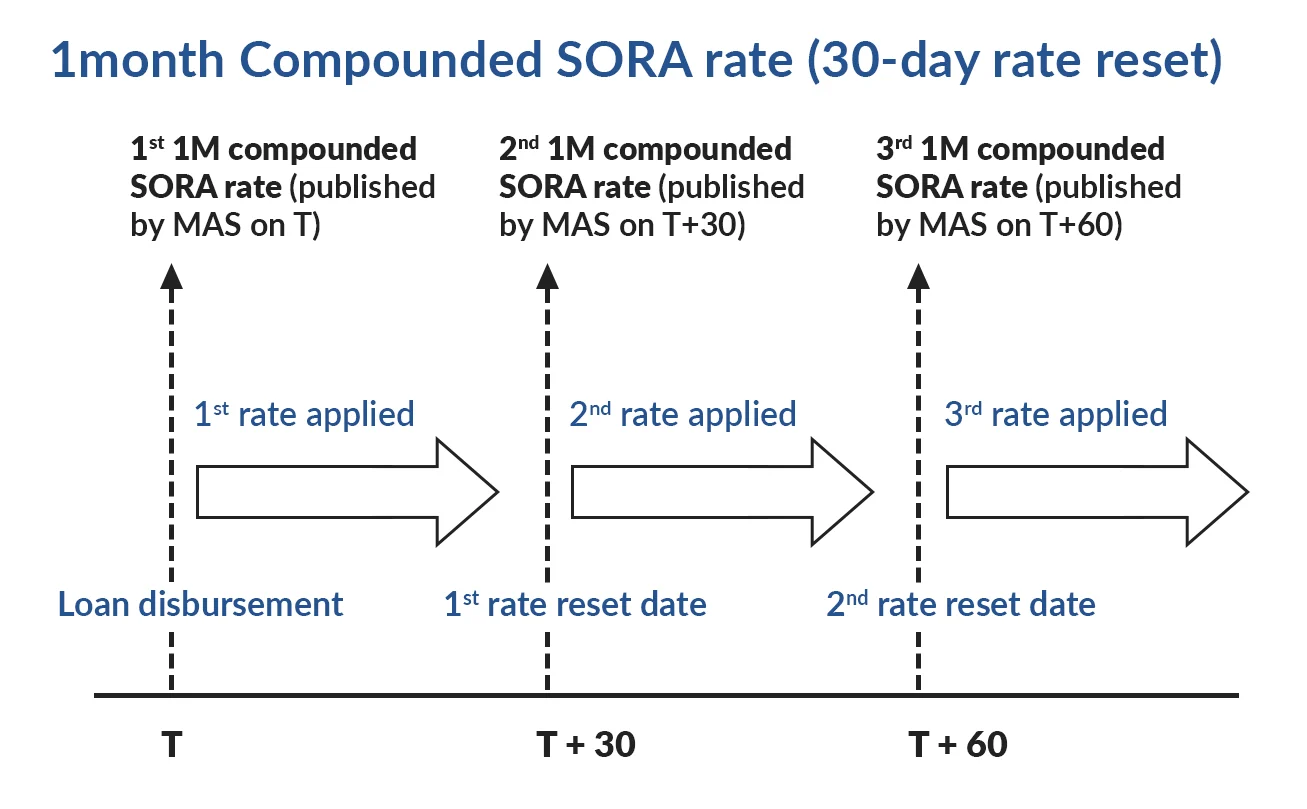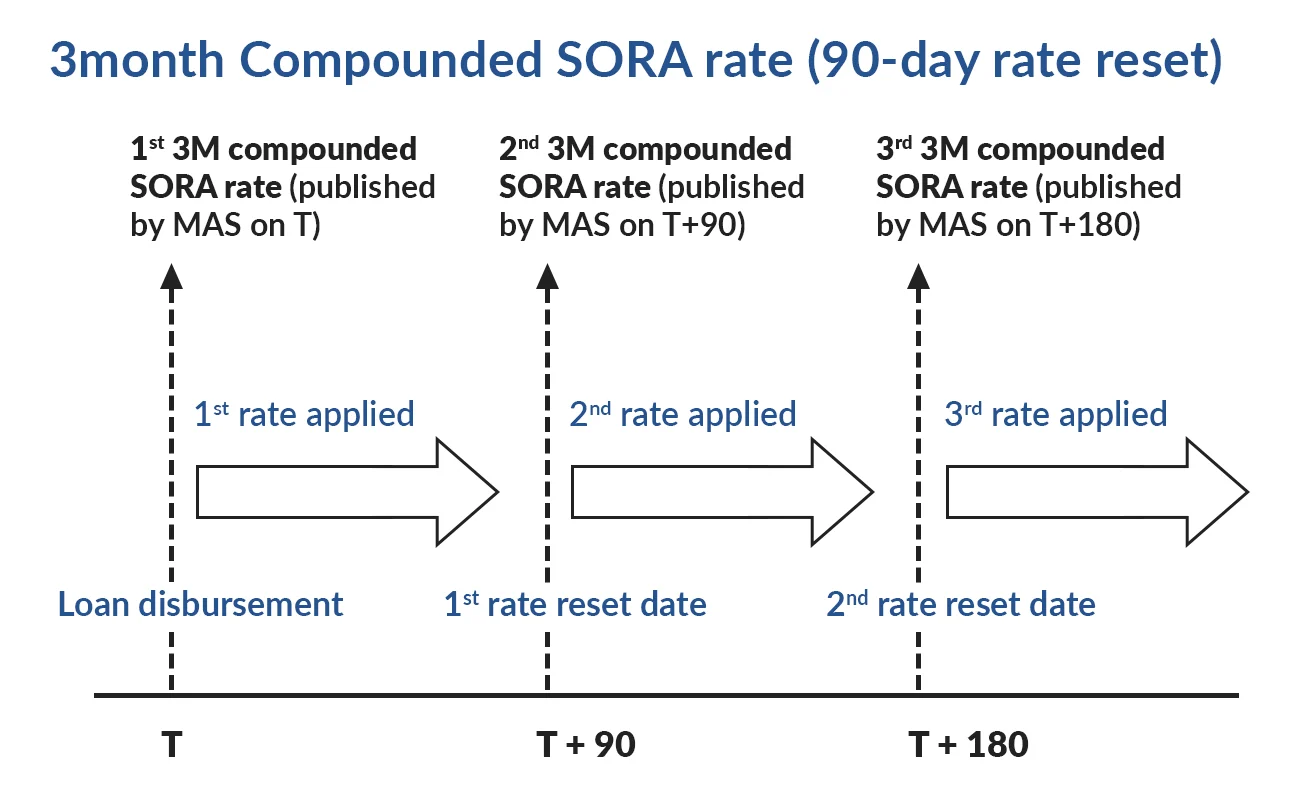- How to Understand Your Credit Report
- What's New: Release Of Tripartite Guidelines For Flexible Work Arrangements In 2024
- Singapore Businesses’ Guide to Hiring Interns + Grants For Interns [2024 Updated]
- Why should your company apply for the PW Mark?
- Singapore's Energy Efficiency Grant (EEG) For F&B, Manufacturing and Retail Businesses [2024 Edition]
- All You Need to Know about Singapore Deposit Insurance Corporation (SDIC) w.e.f. 1st April 2024
- All You Need to Know about Singapore Deposit Insurance Corporation (SDIC)
- How to Rebuild Credit After Bad Debts
- SME Matters: Why SMEs in Singapore Should Consider Having Multiple Business Bank Accounts
- Banker's Guarantees vs Insurance Bonds: What You Need To Know In 2024
Transitioning from SIBOR to SORA: Key Changes You Need To Know Before June 2024

Introduction
As of June 2024, Singapore will transition from using the Singapore Interbank Offered Rate (SIBOR) to the Singapore Overnight Rate Average (SORA) as the key benchmark rate for various financial products completely. This move aims to improve the country's financial market resilience and enhance transparency, thereby benefiting businesses and consumers alike. This shift will require adjustments from lenders, borrowers, and the industry as a whole. Therefore, it's crucial to understand the key changes involved and prepare accordingly for a smooth transition. In this article, we will explore the critical aspects of transitioning from SIBOR to SORA.
Brief explanation of SIBOR and SORA
SIBOR and SORA are both reference rates used in Singapore to determine interest rates for financial products like mortgages, loans, and derivatives. SIBOR, or the Singapore Interbank Offered Rate, is computed as the average of submissions from a panel of banks, and the rate is quoted on a daily basis.
In contrast, SORA, or the Singapore Overnight Rate Average, is based on transactions that occur in the overnight interbank lending market. It is computed as the volume-weighted average rate of all overnight Singapore Dollar transactions, and it is published on the following business day.
The key difference between SIBOR and SORA is in their respective computation methods. While SIBOR is based on submissions from panel banks, SORA is based on actual transactions in the market. Because SORA is less susceptible to manipulation, it is considered to be more reliable and predictable than SIBOR.
Importance of transitioning from SIBOR to SORA
SIBOR has been the primary interest rate benchmark in Singapore for over three decades. However, it has become vulnerable to rate fluctuations and is primarily a backwards-looking overnight rate with very little predictability and transparency.
On the other hand, SORA is a volume-weighted average rate based on actual transactions in the overnight funding market, providing greater predictability, transparency, and reduced volatility. The transition to SORA will mitigate the risks posed by SIBOR and help build a stronger financial system in Singapore.
Existing loans tied to SIBOR will all be automatically transitioned to SORA by June 2024.
The switch to SORA may cause interest rate adjustments for borrowers. SORA is a backward-looking overnight rate, while SIBOR is forward-looking. Borrowers may need to refinance to handle interest rate fluctuations. Lenders may offer SORA conversion packages and new loan products during the transition from Aug 1, 2023 to Apr 30, 2024.
Reasons for Transitioning from SIBOR to SORA
As mentioned in the earlier section, SIBOR has been the primary benchmark reference rate for loans in Singapore, but it is no longer sustainable in the long run; banks are already preparing for this change. Here are some reasons behind the decision to transition from SIBOR to SORA.
- The shift to SORA would mean that loans, including mortgage loans, will be based on the compounded 3-month SORA rate. Although the switch may have limited impact on existing loans, new loans will benefit from a savings of about 10-20 basis points.
- The industry-wide transition to SORA is a significant step towards building a more robust and transparent financial system and securing Singapore's standing as an international financial center. By adopting this more reliable benchmark, financial institutions will be able to offer enhanced loan products to retail and business customers with confidence, while also ensuring that the applicable interest rates remain fair and justifiable.
- The transition from SIBOR to SORA involves significant changes in interest rate calculations that aim to offer greater stability and reliability. SIBOR, or the Singapore Interbank Offered Rate, relies on borrowing rates from a panel of 20 banks. In contrast, SORA, or the Singapore Overnight Rate Average, uses all interbank lending transactions between banks for the Singapore Dollar.
- As more financial products move away from SIBOR towards SORA, businesses and retail consumers can expect a streamlined and standardized approach to interest rates. With SORA, calculations are simpler and more straightforward, creating a smoother transition for existing loans and new financing options.
Key Changes and Implications for Singaporeans
One of the key changes is the replacement of SIBOR with SORA as the primary interest rate benchmark for Singapore Dollar (SGD) financial products. As such, it is a reflection of the actual cost of borrowing SGD funds in the interbank market. It also affects Singaporeans with loans based on foreign exchange rates.
Fuel Your Business Ambitions Now! Apply for Your Business Loan Today with Smart-Towkay
Calculation Methodology
The transition from SIBOR to SORA has brought changes in the calculation methodology for loans. SORA loans are based on either a 1-month or 3-month compounded SORA rate. The 1-month compounded rate is based on the Volume-Weighted Average Rate (VWAP) of the SORA Index on each Business Day in the relevant month. The 3-month compounded rate is based on the VWAP of the SORA Index on each Business Day in the relevant quarter.
Compounding works by adding the interest earned periodically back into the principal amount, resulting in interest being earned on an increasing balance over time. For SORA loans, the interest accrued each day is added to the principal amount and earns interest on the following day.
Day "T" is defined by banks as the day that interest on the loan is calculated and charged. The applicable interest rate is determined by the lender, and may fluctuate if there are changes in the SORA Index. It is important for borrowers to understand the compounding and rate conditions of their SORA loan and how Day "T" is defined by their respective banks to effectively manage their finances.
When transitioning from SIBOR to SORA, it's also important to understand the difference between simple and compounded interest calculation. Compounded interest refers to interest earned on the principal amount plus the accumulated interest, whereas simple interest is calculated only on the principal amount.
SORA rates use compounded interest calculation, which means that interest earned is reinvested and added to the principal amount at regular intervals. This results in a higher effective interest rate and can affect the total amount paid back over the loan tenure.
Additionally, SORA rates use advance compounding, which provides notice of the applicable interest rate and the monthly installment payable until the next rate reset date meaning that borrowers will know in advance how much they will need to pay each month, allowing them to plan their finances appropriately.
With advance compounding, borrowers can benefit from knowing their installment amounts in advance and plan their finances accordingly, resulting in a smoother transition.
Reference Rate Changes
The two primary changes under reference rate include the shift from backwards-looking overnight rates, such as SIBOR, to forward-looking term rates known as SORA, and the use of the volume-weighted average rate (VWAR) as the primary calculation methodology. The 3-month SORA compounded on a daily basis will be used for loan purposes, and the rate will reset once every 30 days. In contrast, the 1-month compounded SORA rate will be used for the calculation of the net interest margin (NIM).
The adjustment spread is introduced so that the respective banks can arrive at an all-in rate that accurately reflects the applicable interest rate. Retail customers can look forward to a lock-in period of up to five years that protects them from rate fluctuations and guarantees clarity on their rate housing loan package.
In the event of an unforeseen increase in interest rates, it is possible to remain calm and avoid panic as the payment amount will remain unchanged regardless of fluctuations.
Fuel Your Business Ambitions Now! Apply for Your Business Loan Today with Smart-Towkay
Transitioning to a fixed-rate loan will require a recalculation of your LTV and TDSR based on current cooling measures.
The industry-wide transition will be implemented through two phases. The first phase involves allowing the customers to convert SIBOR retail loans to SIBOR-SCP (Convert or Switch) or another bank's prevailing package. This decision can be made during the active transition period. The second phase, which is the automatic conversion, will be triggered on June 2024.
Market and Industry Impact
Financial institutions and banks must adjust their operations and products due to the transition. They will need to use SORA instead of SIBOR which will definitely require changes to their systems and processes, which were based on SIBOR, and ensure they have enough liquidity to handle the transition.
Several prominent banks, including DBS Bank, United Overseas Bank, and OCBC Bank, will be impacted by the transition and will need to either replace their current SIBOR-based products with SORA-based products or modify their existing offerings to align with the new benchmark.
The shift from SIBOR to SORA as the primary interest rate benchmark in Singapore may have significant implications for the property market and mortgage loans.
The adoption of SORA could also lead to adjustments in borrowing costs for homeowners. Homeowners may need to refinance their loans to benefit from the lower borrowing costs that SORA may offer.
However, the transition from SIBOR to SORA may not be immediate, and homeowners should be mindful of any potential impact on their loan packages.
Transition Timeline and Deadlines
The decision to transition to SORA came after global regulators stated they would no longer guarantee the availability of the London Interbank Offered Rate (LIBOR) which has been widely used to benchmark financial products including loans and mortgages across the globe. The plan aims to minimize disruptions in the financial markets, limit risks associated with the use of backward-looking benchmark rates and align with the global trend of adopting overnight risk-free rates.
The plan includes milestones and deadlines such as the cessation of the 1-month and 3-month SIBOR rates by end-2021 and the establishment of a waterfall methodology for SORA-derived interest rates. Borrowers and financial institutions have been advised to prepare for the transition and incorporate updated loan conditions and applicable interest rates.
Firstly, the discontinuation of SIBOR and SOR will take place on the 31st of December 2024. However, from March 2021, no new SOR or SIBOR-linked loans or financial products can be issued. Secondly, the transitional period for existing SIBOR and SOR-linked contracts will end by the 30th of June 2023.
Thirdly, the rollout of SORA takes place in phases, with the first phase starting in August 2020 and the second phase taking place in October 2021. By November 2021, the 1-month and 3-month compounded SORA rate will be published daily. The final phase will see the publication of the volume-weighted average rate computation by May 2023.
As a borrower or lender, it is crucial to keep track of these key milestones and deadlines as the new benchmark rate SORA will affect all applicable interest rates.
Government Support and Guidance
The transition from SIBOR to SORA is a major industry-wide shift that requires collaboration between the Monetary Authority of Singapore (MAS) and industry stakeholders. The Association of Banks in Singapore (ABS) has also formed a steering committee to facilitate the transition, with members from major banks and industry associations.
MAS has provided guidance and resources to help consumers understand the changes, including educational materials and public consultations. The central bank also introduced SORA-based financial products, such as loans and derivatives, to support the transition. The SORA Transition Roadmap provides an overview of the timeline and key milestones for the transition.
To ensure consumer protection, MAS has issued guidelines for financial institutions on fair and transparent pricing, disclosure, and communication. Banks are also required to offer customers a conversion package that includes options for the transition, such as the SORA-based interest rate or adjustment spreads. The lock-in period for the conversion package should not be longer than three months.
You can also access information on financial institution websites for SORA conversion packages and other relevant details. Government publications such as the Digital Financial Assets and Good Practice Guide for Treasury Management also provide further guidance to assist consumers.
Consumers can make informed decisions and take necessary actions to ensure a smooth transition from SIBOR to SORA.
During the transition from SIBOR to SORA, financial institutions must abide by certain guidelines to protect their consumers. The Monetary Authority of Singapore (MAS) oversees this transition to ensure that it is conducted in a fair and transparent manner.
You can also explore MAS setup of a Consumer Outreach Group to ensure that consumers are aware of the transition and its implications for your loans. This group works to educate consumers about the upcoming changes and advises them on how to choose the best loan packages based on the new benchmark rates.
Exploring refinancing options and considerations
If you currently have a home loan with a SIBOR-based interest rate, you may want to start exploring refinancing options as the industry moves toward transitioning to the SORA benchmark by June 2024.
Firstly, you should compare the SIBOR and SORA floating rates to see which one suits your financial situation better. Then you evaluate the whole loan package offered by banks, not just its interest rate. Consider factors such as lock-in periods, all-in rates, and any other fees or charges.
Try consulting with a trusted mortgage broker who can give you more insight into the available loan packages to find the best one for you!
Smart-Towkay's dedicated team is here for a free consultation if you are unsure about what to do next about your options.
Conclusion
The ongoing global shift away from interbank offered rates highlights the need for transparency and reliability in benchmark interest rates. SORA's usage sets a new standard for these qualities, being based on actual transactions and providing a volume-weighted average rate.
Financial institutions will need to adapt to this change, adjusting their financial products and transition packages for borrowers. Borrowers, on the other hand, may experience the impact of rate fluctuations and potential lock-in periods. However, the transition to SORA is expected to improve the pricing and risk management of financial products, ultimately benefiting customers.
This shift is a part of a larger movement towards more effective and fair rate benchmark mechanisms globally. As we look towards the future, the use of forward-looking term rates and 30/90-day rate resets may become more popular, alongside the removal of backwards-looking overnight rates. The ongoing transition highlights Singapore's commitment to improving the financial sector and ensuring the reliability and fairness of interest rate benchmarks.
Frequently Asked Questions
What is the difference between SIBOR and SORA?
SIBOR is a benchmark rate that reflects the average rate at which banks lend to each other in the Singapore interbank market. SORA, on the other hand, is the Singapore Overnight Rate Average. It measures the volume-weighted average rate of all unsecured overnight interbank SGD transactions brokered in Singapore.
Why is there a need to transition from SIBOR to SORA?
The shift from SIBOR to SORA is a global movement due to concerns regarding the reliability and robustness of interbank offered rates (IBORs) such as SIBOR. SORA, a backward-looking overnight rate, is more reliable as it represents actual overnight funding rates in Singapore.
What are the key changes to expect during the SIBOR to SORA transition?
The transition requires the use and adoption of SORA as a replacement rate. This requires significant changes to financial products and systems. Lenders will need to update their systems, documentation, and processes to use SORA as the benchmark rate. Borrowers will also need to be informed and educated on the changes.
What are the implications of the SIBOR to SORA transition?
The switch from SIBOR to SORA may have implications on various financial products, especially loans and mortgages. There may be effects on the rates at which banks borrow from each other and could result in fluctuations in interest rates. However, the Monetary Authority of Singapore has assured borrowers that the transition will be gradual and will not affect existing loans as yet (at the time of writing this article).
Is there government support and guidance for the SIBOR to SORA transition?
A: Yes, the Monetary Authority of Singapore has provided ample guidance and support to financial institutions, including a transition roadmap that highlights key milestones and timelines. The government is also encouraging financial institutions to help their clients transition smoothly with minimal disruption by offering transition packages to help offset the costs of the transition.
Read also: Navigating Singapore's Budget 2023: What Businesses Need to Know
Read also: Should You Refinance Your Property Loan In 2020? And Should You Opt For a sora-Pegged Home Loan Now?
-------------------------------------------------------------------------------------------------------
Got a Question?
WhatsApp Us, Our Friendly Team will get back to you asap :)
Share with us your thoughts by leaving a comment below!
Stay updated with the latest business news and help one another become Smarter Towkays. Subscribe to our Newsletter now!






_940.png)











